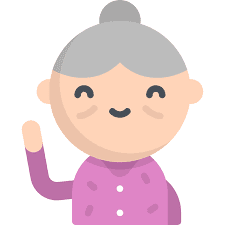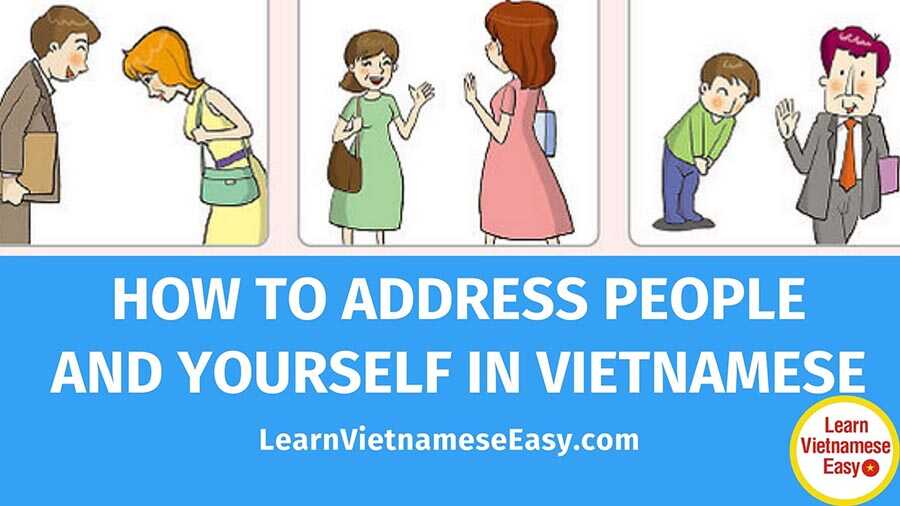Today we will learn how to use Vietnamese personal pronouns in Southern dialects corectly and naturally. For foreigners, addressing people is quite confusing when they have started learning Vietnamese because in English we only use “I” and “you” to address yourself and the listeners.
However, in Vietnamese, based on the age, gender and generation, we will adress person with a suitable pronoun. But don’t worry, I will make it easy. Let’s get started.
CONTENTS
How to address people in Vietnamese
🔹 If they are in your grandparents’ generation, you will call him “ông” and call her “bà“.
🔹 If they are in your parents’ generation, you will call him “chú” and call her “cô“.
🔹 If they are in your generation
- They are older than you, you will call him “anh” and call her “chị“. (Like your older siblings)
- They are younger than you, you will call them “em“. (Like your younger siblings)
🔹 If they are in the generation as your child, grandchild, niece or nephew, you will call them “con“.

Ông
He is old enough to be your grandpa or around your grandpa’s age.

Bà
She is old enough to be your grandma or around your grandma’s age.

Chú
He is old enough to be your daddy or around his age.

Cô
She is old enough to be your mommy or around her age.

Anh
He is old enough to be your older brother or around his age.

Chị
She is old enough to be your older sister or around her age.

Bạn
He/She is the same age as you (both males and females)

Em
He/She is around your younger siblings’ age (both males and females)

Con
He/She is around the age of your child, grandchild, niece and nephew (both boys and girls)
![]() Note: There are one more way to address people that they are the same age as you or younger than you, you can address them with their name.
Note: There are one more way to address people that they are the same age as you or younger than you, you can address them with their name.
That’s how you address other people. So now how can you address youself when talking to Vietnamese? It’s opposite.
How to address yourself in Vietnamese
🔹 If they are in the generation of your parents and your grandparents or around their age, you will be “con” (Because you are around the age of their child, grandchild, niece and nephew)
🔹 If they are like your older siblings, you will be “em” (Because you are around the age of their yourger brother or sister)
🔹 If they are around your age, you will be “mình” or you can use your name.
🔹 If there are like your younger siblings, you will be “anh” (for males), “chị” (for females) (Because you are around the age of their older brother or sister)
🔹 If there are around the age of your children, nieces or nephews, you will be “chú” (for males), “cô” (for females). (Because you are around the age of their parents)
🔹 If there are around the age of your grandchildren, you will be “ông” (for males), “bà” (for females).(Because you are around the age of their grandparents)
![]() Note: In English, 1st and 2nd pronouns, we have subject pronouns and object pronouns such as “I, you, me”. However, in Vietnamese, they are the same.
Note: In English, 1st and 2nd pronouns, we have subject pronouns and object pronouns such as “I, you, me”. However, in Vietnamese, they are the same.
➡️ Let’s do an example:

James, 30 years old
Let’s imagine you are James. So how do you address yourself and the person that you are talking to?
Here are 6 people. Let’s practice to say hello and introduce your name.
![]() Note: To saying hello politely and respectfully to people that older than you, do not forget to add your pronoun first.
Note: To saying hello politely and respectfully to people that older than you, do not forget to add your pronoun first.
Ví dụ: em chào anh, em chào chị, con chào cô, con chào chú,… (Literally “I – hello – you”)

Thủy (around 55)
James: Con chào cô, con tên James.
Thủy: Chào con, cô tên Thủy.

Huy (around 80)
James: Con chào ông, con tên James.
Huy: Chào con, ông tên Huy.

Linh (around 25)
James: Chào em, anh tên James.
Linh: Em chào anh, em tên Linh.

Bình (around 30)
James: Chào bạn, mình tên James.
Bình: Chào bạn, mình tên Bình.

Hương (around 10)
James: Chào con, chú tên James.
Hương: Con chào chú, con tên Hương.

Dũng (around 60)
James: Con chào chú, con tên James.
Dũng: Chào con, chú tên Dũng
In conclusion, we have some pairs of pronouns in Vietnamese, they are:
- ông ↔️ con
- bà ↔️ con
- chú ↔️ con
- cô ↔️ con
- anh ↔️ em
- chị ↔️ em
- bạn ↔️ mình
How to address the third person in Vietnamese
We just simply add their names after their pronouns or put the word “ấy” after the pronouns
- Pronoun + name
- Pronoun + “ấy”
Ví dụ (eg):
- anh James, chị Anna, chú Hùng, cô Trang, ông Tám, bà Hồng…
- anh ấy (=ảnh), chị ấy (=chỉ), cô ấy (=cổ), chú ấy, ông ấy, bà ấy


That was super super helpful. thanks!
Hi Aru, thank you so much for your comment, it’s a great inspiration for me to do more. Hope you enjoy learning Vietnamese.
This is an excellent explanation